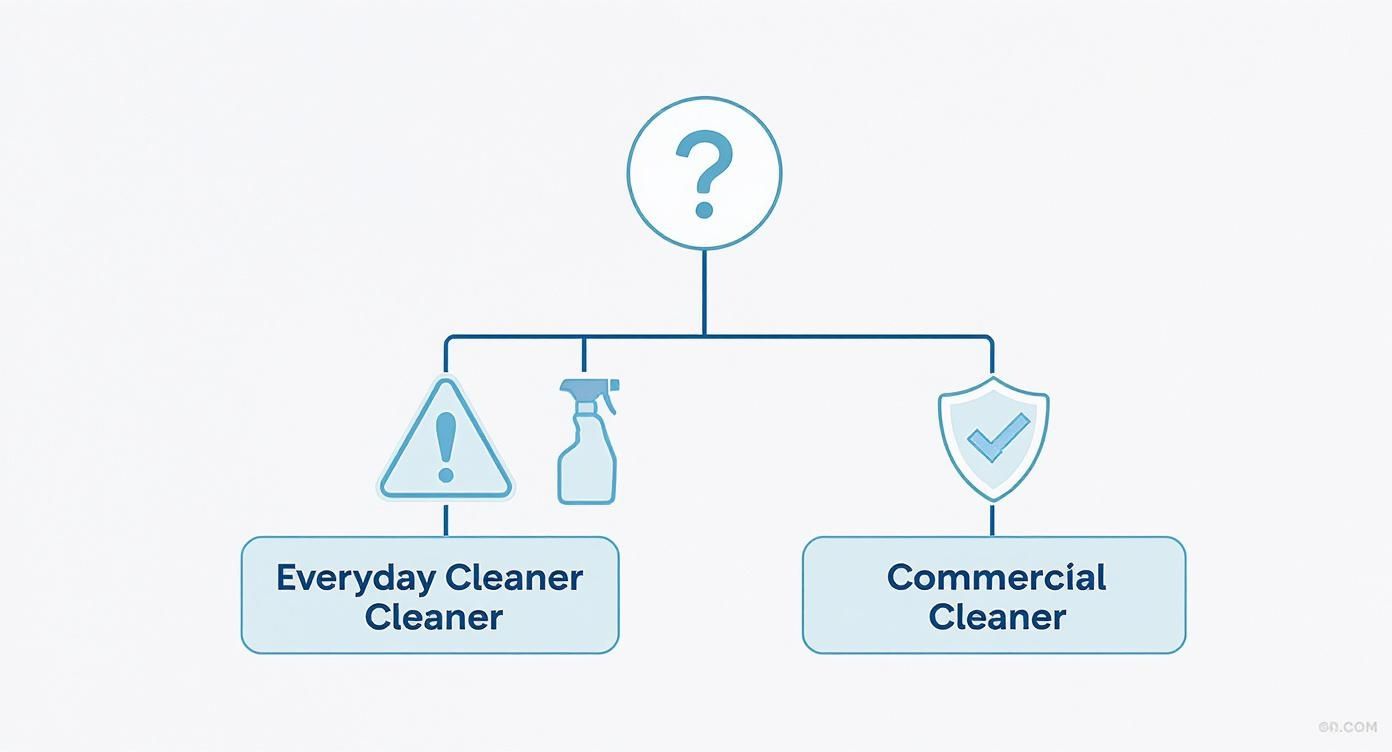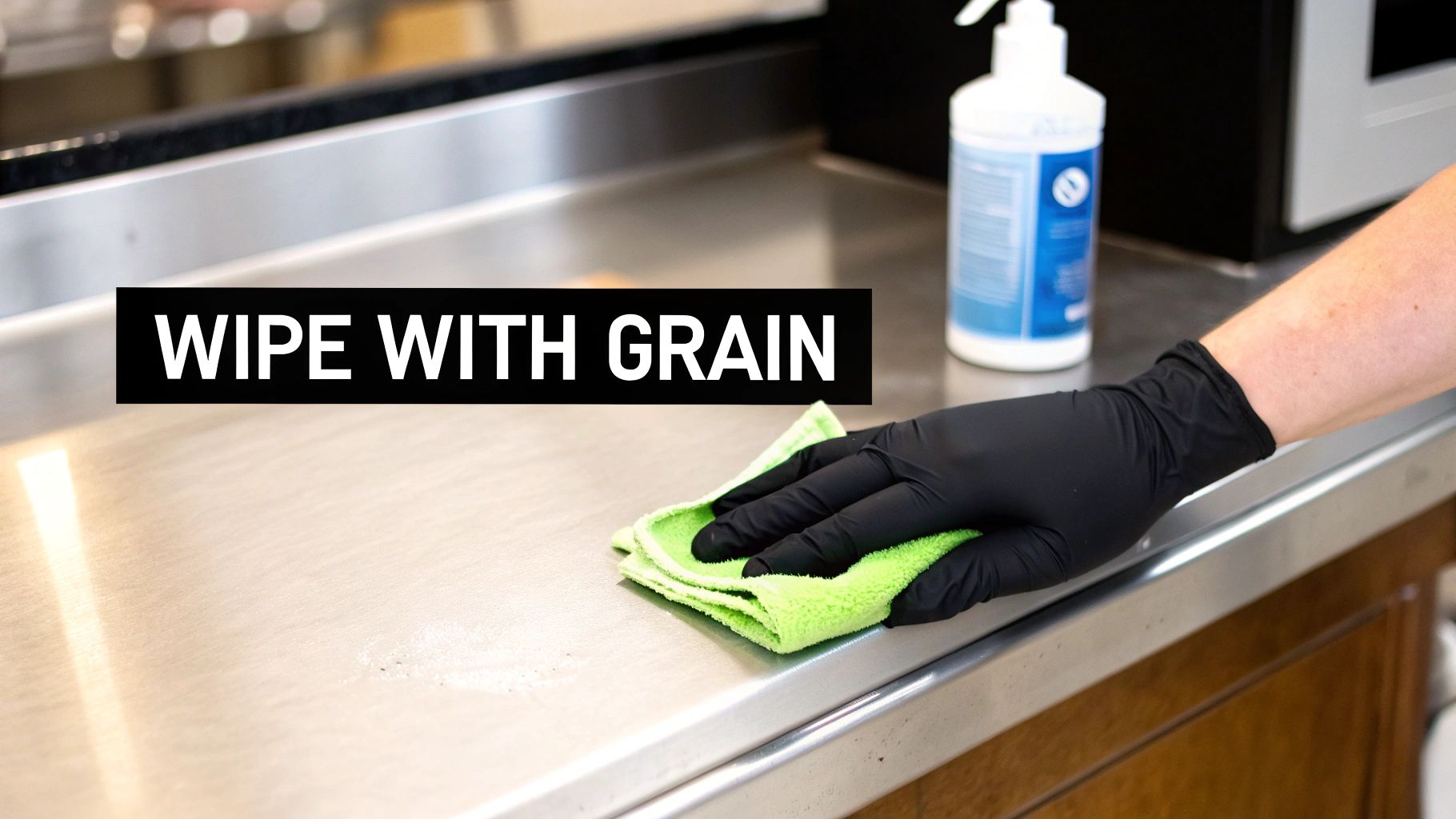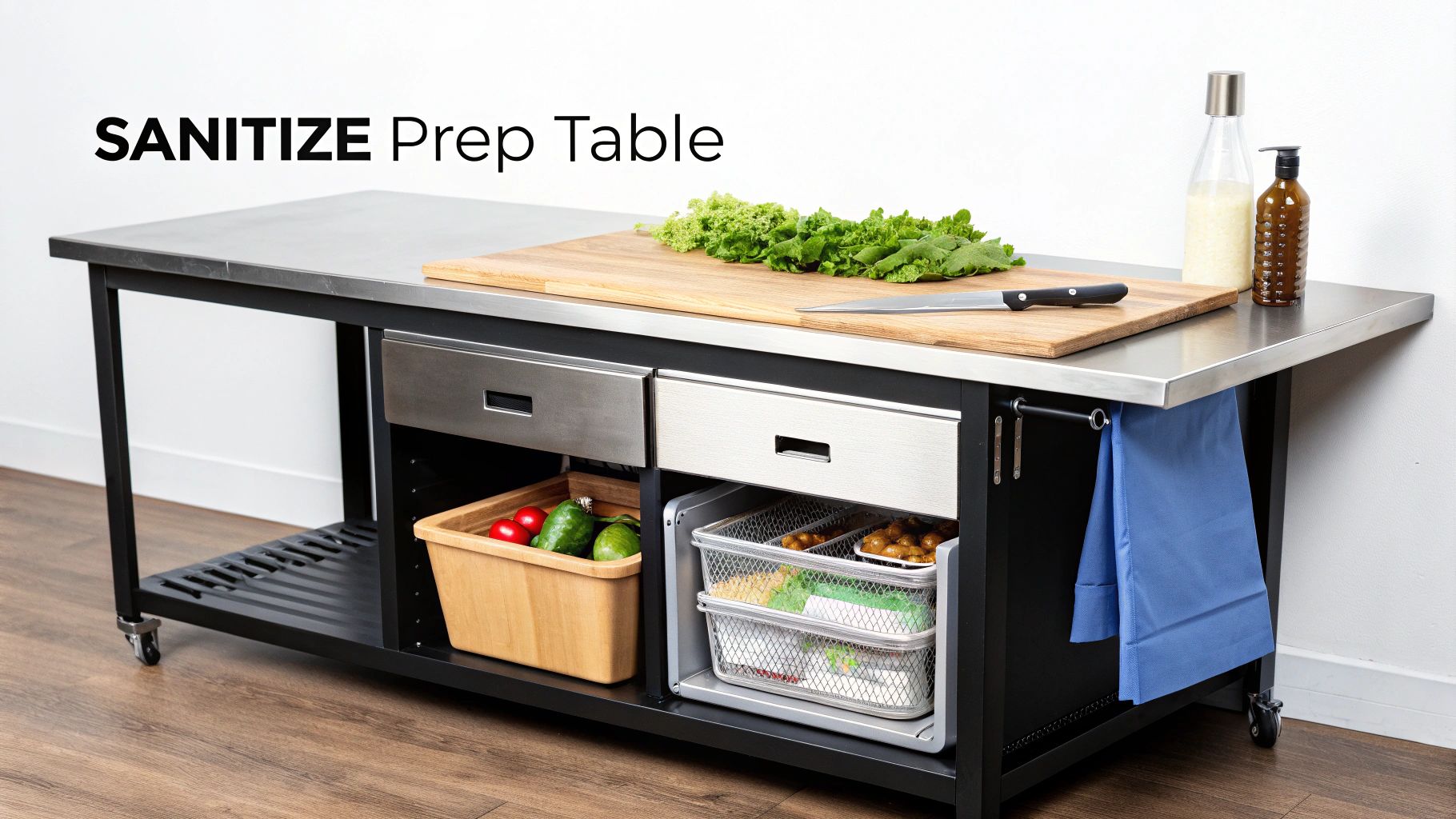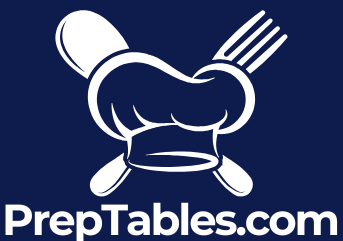
Commercial Stainless Steel Cleaner Guide
Share
In a high-traffic commercial kitchen, cleanliness is everything. It's about food safety, passing inspections, and protecting the reputation you've worked so hard to build. A high-quality commercial stainless steel cleaner is your best friend here, specifically formulated to slice through the toughest kitchen grease without harming your expensive equipment.
This guide is all about helping you protect that investment and keep every surface in pristine, hygienic condition.
Understanding Your Stainless Steel Surfaces
Before you grab a bottle and start spraying, it’s important to know what you’re working with. Not all stainless steel is the same, especially when it comes to the prep tables that are the true workhorses of your kitchen. The specific type of table you have determines the best way to clean it and what it's most vulnerable to.
Standard Work Tables
These are the flat-topped, all-purpose surfaces you see in every kitchen. They're where the magic happens, from dicing onions to portioning out steaks. Their simple design makes them seem easy to clean, but because they are high-contact surfaces, they need constant, thorough sanitation to stop cross-contamination in its tracks. They are available with or without a backsplash and often feature an undershelf for extra storage. Their versatility makes them a staple, but it also means they require a strict cleaning protocol, which we cover in our detailed resource on food safety sanitation guidelines.
Specialized Prep Tables
Go beyond the basic work table, and you'll find specialized units built for very specific jobs. These tables often mix stainless steel with other materials, which can make cleaning a bit more complex.
- Pizza Prep Tables: A cornerstone of any pizzeria, these units feature a stainless steel work surface combined with refrigerated wells or "cold rails" designed to keep toppings like cheese and pepperoni cool and safe. The real cleaning challenge is finding a commercial cleaner that’s tough on grime but won't damage the refrigeration components or the plastic ingredient pans. You have to be meticulous around gaskets and seams where stray bits of food love to hide.
- Sandwich Prep Tables: Much like pizza tables, these are designed for efficient assembly lines, featuring chilled compartments for meats, cheeses, and spreads. They also typically incorporate a built-in poly cutting board, which needs its own separate cleaning and sanitizing routine to prevent bacterial growth. The surrounding stainless steel has to be cleaned just as carefully to maintain a safe and integrated prep zone.
A classic mistake is forgetting the spots where different materials connect—like the seam where a stainless steel counter meets a poly cutting board. These little crevices are breeding grounds for bacteria and need extra attention during cleaning.
Daily wipedowns are crucial, but to achieve a truly hygienic kitchen, you should work a full deep clean into your regular schedule. For a complete walkthrough, check out this ultimate guide to a sparkling kitchen deep clean.
When you know the quirks of each prep table, you can use the right cleaning methods to keep your kitchen spotless and, most importantly, safe.
How to Choose the Right Cleaner for Your Equipment
Walk into any commercial kitchen, and you'll see a lot of stainless steel. But not all cleaners are made for the heavy-duty demands of a professional environment. Picking the wrong one isn't just a waste of money—it can damage your equipment.
The market for these cleaners is huge, valued at $3.26 billion in 2023 and expected to climb to $5.0 billion by 2032. That growth is fueled by kitchens like yours that need products that actually work. A commercial stainless steel cleaner is formulated specifically to handle the grease and grime that a home kitchen just doesn't see. You wouldn't use the same cleaner for a few fingerprints as you would for caked-on grease after a packed Friday night service.
Understanding Cleaner Formulations
The magic is in the chemistry. The formula of a cleaner dictates what it's good at, and you'll mostly run into two types: alkaline and acidic.
- Alkaline Cleaners (Degreasers): Think of these as your heavy hitters. They have a high pH that's fantastic at breaking down grease, oil, and old food residue. This is what you want for cleaning fryers, range hoods, and those prep surfaces that see the most action.
- Acidic Cleaners: These are your go-to for mineral deposits. If your kitchen has hard water, you know that chalky white film that builds up over time. Acidic cleaners dissolve that, along with rust spots, to bring back the original shine.
A lot of people think stronger is always better, but that's a common mistake. Using a powerful degreaser for light daily wipedowns is overkill. Save the strong stuff for the jobs that really need it.
For everyday smudges and fingerprints, a simple pH-neutral cleaner is your best bet. It gets the job done without being too harsh on your surfaces.
This simple chart can help you decide when you need to break out the serious commercial stuff versus a simple daily cleaner.

The bottom line is that a professional kitchen absolutely needs a dedicated commercial cleaner in its arsenal for the heavy-duty jobs.
Comparing Cleaner Types
To get the best results, you need to match the cleaner to the job. Here's a quick breakdown of the most common types and where they shine.
Commercial Stainless Steel Cleaner Comparison
| Cleaner Type | Best For | Avoid On | Key Feature |
|---|---|---|---|
| Sprays | Large, flat areas like countertops & doors | Intricate parts where drips matter | Provides quick, even coverage for daily cleaning. |
| Foams | Vertical surfaces like backsplashes & hoods | Enclosed spaces without ventilation | Clings to surfaces for better contact time. |
| Wipes | Quick spot-cleaning & high-touch areas | Large-scale deep cleaning jobs | Convenient for immediate messes and sanitizing. |
| Polishes | Final finishing touches on any surface | Greasy or heavily soiled areas | Leaves a protective barrier that resists smudges. |
A spray cleaner is perfect for your main prep table, but a foaming one will work much better on the side of a deep fryer where grease tends to run. Wipes are great for a quick clean of a door handle, and a polish is what gives everything that final, streak-free gleam.
The Non-Negotiable Food-Grade Standard
This is the most important part: if a surface touches food, your cleaner must be food-grade. No exceptions.
Always look for a commercial stainless steel cleaner that is NSF-certified. This certification is your guarantee that the product has been rigorously tested and is safe to use in a food prep environment. Using a non-certified cleaner can introduce dangerous chemicals into your food, which is a serious health risk you can't afford to take.
For a deeper look into what makes a great cleaner, this guide to choosing a good cleaner for stainless steel has some more excellent tips.
The Best Way to Clean Stainless Steel
Having the right commercial stainless steel cleaner is only half the battle. I've seen countless kitchens invest in top-tier products only to get frustrating, streaky results. The secret to that flawless, mirror-like finish? It's all in the technique.
It really comes down to the small details—like which direction you wipe and the type of cloth you use. These are the things that make the difference between a dull, smudgy surface and one that looks professionally maintained.

If you take away only one thing, let it be this: always clean with the grain of the steel.
Just like wood, stainless steel has a grain—those faint, directional lines running across its surface. Wiping against these lines is a surefire way to create micro-scratches and trap cleaning residue, which is exactly what causes those frustrating streaks.
To find the grain, just look closely at your equipment. You’ll see very fine lines running either horizontally or vertically. Make sure every single wipe, from applying the cleaner to the final buff, follows that direction. This simple adjustment ensures you're working with the metal, not against it, for a much cleaner, professional result.
Your Essential Cleaning Toolkit
You don't need a massive arsenal of supplies. In fact, keeping it simple is better. Consistency is what gets results, and equipping your team with a straightforward, effective kit makes all the difference.
Here’s what you actually need:
- Microfiber Cloths: Ditch the paper towels and old rags. Microfiber cloths are non-abrasive, and their tiny fibers are specifically designed to lift and trap dirt, oil, and moisture without leaving scratches. Always have at least two ready—one for cleaning and a separate one for drying and buffing.
- A Quality Cleaner: For most daily wipe-downs, a good pH-neutral cleaner is all you need. But for the heavy grease buildup you see on a range hood or fryer, you’ll want to bring out a powerful alkaline commercial cleaner designed for the job.
- A Spray Bottle: Here's a pro-tip: always apply cleaner to your cloth first, not directly onto the steel surface. This gives you way more control, prevents you from using too much product, and helps avoid the residue buildup that leads to streaks.
Step-by-Step Cleaning Process for Everyday Scenarios
Let’s walk through a real-world situation. Imagine cleaning a prep counter after a chaotic dinner service. It's probably covered in food bits, grease spots, and watermarks.
First, grab a dry microfiber cloth and clear off any loose debris. Just a quick wipe will do.
Next, lightly spray your chosen cleaner onto a clean microfiber cloth. You don't need to soak it; a little really does go a long way.
Wipe the entire surface firmly, always moving with the grain. If you hit a stubborn, stuck-on food spot, apply a bit more pressure or let the cleaner sit for a minute to do its work. Whatever you do, resist the urge to scrub in circles—stick with the grain!
The biggest mistake I see teams make is letting the surface air-dry. This is a guaranteed recipe for water spots and streaks. You absolutely have to use a second, completely dry microfiber cloth to buff the surface until it’s dry and shiny.
This final buffing step is what removes any last traces of moisture and cleaner residue. It’s the non-negotiable secret to a perfect, polished finish every time.
For an even deeper dive into techniques, you can learn more about how to clean stainless steel and keep it looking brand new in our comprehensive guide. Mastering these simple steps will ensure every piece of equipment reflects the high standards of your kitchen.
Cleaning Stainless Steel Prep Tables and Stations
Your prep tables are the absolute heart of your kitchen, and they need to be treated that way with specific cleaning protocols. The right technique is everything, but the type of table you're cleaning—whether it's a simple work surface or a complex refrigerated station—really dictates your approach. Trying to use a one-size-fits-all method is a recipe for hygiene gaps and potential equipment damage.

Understanding the small differences between these tables is the first real step toward keeping them in top shape. A standard work table just doesn't have the same needs as a refrigerated pizza prep unit packed with different compartments.
Standard Work Tables and Their Cleaning Needs
Think of standard stainless steel work tables as the uncomplicated workhorses of your kitchen. Their flat, open surfaces see everything from chopping vegetables to plating the final dish. Because they're so versatile, they are high-contact zones that can quickly build up food particles, juices, and bacteria.
For these surfaces, a solid two-part cleaning routine is a must:
- Daily Sanitization: All day long, these tables need to be wiped down with a food-safe commercial stainless steel cleaner and sanitized to stop cross-contamination in its tracks. This isn't just a quick wipe; it's a systematic process to make sure the entire surface is safe for direct food prep.
- Deep Cleaning: At least once a week, it's time for a more intensive deep clean. This means breaking out a stronger degreaser to tackle any stubborn, baked-on grime that daily cleaning might have missed. Pay extra attention to the legs and undershelves—that's where buildup loves to hide.
Specialized Stations: Pizza and Sandwich Prep Tables
Pizza and sandwich prep tables bring a whole new level of complexity to cleaning. These units mash up stainless steel surfaces with refrigerated compartments, ingredient wells, and often, built-in cutting boards. This mix of materials demands a much more careful and targeted cleaning strategy. You can't just go spraying a heavy-duty degreaser everywhere.
The biggest risks with these specialized stations are cross-contamination between the ingredient wells and accidentally damaging sensitive components. A cleaner that works miracles on steel might be way too harsh for the plastic pans or rubber gaskets around the refrigerated sections.
When you're cleaning these stations, the focus has to be on getting into all the nooks and crannies around the integrated parts safely. You need a food-grade cleaner that’s tough on steel but won't harm the adjacent materials. It's absolutely critical to remove and individually wash all the ingredient pans and dividers, then meticulously clean out the wells themselves, making sure no food debris gets left behind.
The market for specialized cleaners really shows this need for precision. While the multi-purpose cleaner market was valued at a massive $54.3 billion in 2023, the specialty cleaner segment—which includes targeted formulas for stainless steel—is actually growing faster. The global specialty cleaner market is projected to hit $12.27 billion by 2030, which tells you that kitchens are wisely investing in the right product for the right job to protect their equipment.
For a deep dive into all the different types of tables and how to pick the perfect one for your kitchen, check out our complete guide to choosing a stainless steel prep table. This resource will help you understand your equipment on a deeper level, which leads to better cleaning and maintenance routines that protect your most valuable assets and keep your kitchen running like a well-oiled machine.
Common Cleaning Mistakes to Avoid
Even when you have the best intentions, it's surprisingly easy to do some real damage to your stainless steel surfaces. Grabbing the wrong cleaner or tool can lead to permanent scratches, a dull finish, or even rust over time. Honestly, knowing what not to do is just as important as mastering the right technique.
So many expensive mistakes happen when someone grabs what’s convenient instead of what’s correct. A simple error can turn a quick wipe-down into a costly replacement job.
Using Abrasive Tools and Powders
The single fastest way to ruin your equipment's finish is by using abrasive materials. Reaching for steel wool, a scouring pad, or a gritty powder cleanser might seem like the obvious choice for tough, baked-on grime, but it's a guaranteed disaster for that beautiful finish. These materials create tiny scratches all over the surface, permanently dulling its shine.
Once that protective top layer of the stainless steel is scratched up, it's suddenly much more vulnerable to rust and corrosion. You absolutely must stick to soft, non-abrasive tools.
- The Mistake: Scrubbing with steel wool, Brillo pads, or abrasive sponges.
- The Fix: Stick to microfiber cloths or soft sponges for every cleaning task. For really stubborn spots, a simple paste made from baking soda and water offers a gentle scrubbing action without causing any damage.
The Dangers of Bleach and Harsh Chemicals
Another common pitfall is using cleaners that contain bleach or other harsh chemicals like ammonia. Bleach is a fantastic disinfectant, sure, but the chlorine in it is incredibly corrosive to stainless steel. It can cause pitting and ugly stains, leaving a permanent blemish on your expensive equipment.
Never just assume a general-purpose cleaner is safe for your stainless steel. Always take a second to check the label for ingredients like chlorine or chlorides—these can cause irreversible damage and might even void your equipment's warranty.
Oven cleaners and other aggressive degreasers that aren't specifically made for stainless steel can also be way too caustic. To be safe, always stick with pH-neutral options or a designated commercial stainless steel cleaner.
Letting Surfaces Air Dry
After you've done a thorough cleaning, letting the surface air dry seems harmless, right? Wrong. This is the number one cause of streaks and water spots. Tap water is full of minerals, and when the water evaporates, those minerals get left behind, creating a cloudy, splotchy mess that just ruins all your hard work.
The fix is incredibly simple but so important: always dry the surface immediately with a clean, dry microfiber cloth. This final buffing step gets rid of every last bit of moisture and cleaner, leaving behind nothing but a brilliant, streak-free shine. This one small habit is what separates a kitchen that looks clean from one that looks professionally maintained.
With the food-grade cleaner market projected to hit $2.5 billion by 2033, it's clear that top-tier kitchens are prioritizing proper products and techniques. You can learn more about the growth of the food-grade stainless steel cleaner market and see why it matters.
Common Questions About Cleaning Stainless Steel
Even with the best routine, you're bound to run into a few tricky situations when caring for your commercial kitchen equipment. Let's tackle some of the questions we hear most often to help you keep your stainless steel in top-tier condition.
How Often Should I Be Deep Cleaning My Equipment?
Daily wipe-downs are a given, but a real deep clean needs to be on your regular schedule. How often you do it really comes down to how hard the equipment works.
For the heavy hitters—think range hoods, fryers, and any other surface that battles serious grease—a weekly deep clean is the way to go. For equipment that sees less action, like storage racks or a secondary prep station, a bi-weekly scrub is usually plenty to keep grime from building up.
Can I Just Use a Household Cleaner in My Kitchen?
We get asked this a lot, and the answer is a hard no. A commercial kitchen is a different beast entirely. The amount of grease, food particles, and general gunk is far beyond what a residential cleaner is designed to handle.
The biggest difference-maker is certification. Professional commercial stainless steel cleaner products are often NSF-certified, which means they've been rigorously tested and are proven safe for food-contact surfaces. That's a critical safety standard you just won't find with most cleaners under your kitchen sink at home.
What's the Best Way to Get Rid of Rust Spots?
Seeing rust on stainless steel can be a shock, but don't panic. It's usually just a surface issue caused by contact with other metals (like leaving a cast iron pan sitting on it) or residue from harsh cleaning chemicals.
For those small, annoying rust spots, a gentle approach is your best bet:
- Mix up a thick paste with baking soda and water.
- Slather the paste right onto the rust spot and let it sit for about 15-20 minutes.
- Grab a soft cloth or a non-abrasive sponge and gently scrub, always moving with the grain of the steel.
- Rinse the spot completely with clean water and then dry it thoroughly with a fresh microfiber cloth.
If you’re dealing with more stubborn rust, a cleaner with oxalic acid might be necessary. Just be sure to test it on a small, hidden spot first to make sure it doesn't discolor or damage the finish.
At PrepTables.com, we know that a great kitchen starts with a solid foundation. We supply tough, NSF-certified stainless steel tables and a full lineup of commercial gear built for professionals who value hygiene and performance. Get your kitchen ready for success by checking out our collection at https://preptables.com.
